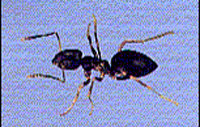|  Odorous
House Ant Odorous
House Ant
Order: Hymenoptera
Family: Formicidae
Scientific Name: Tapinoma sessile (Say)
Color: Brown or black
Legs: Six
Shape: Segmented; oval
Size: 1/16-1/8
Antennae: Yes
Flight: No
This ant gets its name from the strong, rotten coconut-like smell
it gives off when crushed. These tiny insects range in size from
one-sixteenth of an inch to one-eighth of an inch long. Odorous
House ants can be found throughout the United States. Typical colony
size is from several hundred to 100,000 workers and many queens.
Habits
Odorous house ants like to eat sweets, especially melon, but will
also feed on meats and cheese. These ants typically build nests
in wall cavities, preferring to be close to hot water pipes and
in crevices near sinks and kitchen cabinets.
Habitat
Typically living for several years, these ants make their homes
in exposed soil and wall cracks.
Threats
These ants do not pose a public health risk, but they can contaminate
food and should be avoided.
Control
Eliminate standing water. Pests such as odorous house ants are attracted
to moisture. Keep tree branches and other plants cut back from the
house. Sometimes pests use these branches to get into your home.
Make sure that there are no cracks or little openings around the
bottom of your house. Sometimes pests use these to get into your
home. Make sure that firewood and building materials are not stored
next to your home. Pests like to build nests in stacks of wood.
Locating the nest(s) is critical to control. Following ants back
to their nests can be helpful. Use dust formulations in wall voids
along with an exterior perimeter treatment along walls using a residual
liquid insecticide. Baits can be used.
|